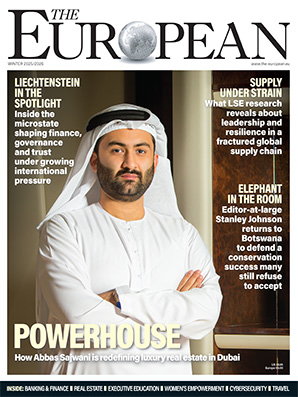In the business of giving

How both businesses and individuals give to charity has been undergoing considerable changes over the past two decades. The advent of SMS messaging made charitable giving easy and accessible for anyone with a mobile phone, with the internet allowing donors to see more clearly where their money is going, and in the process improving transparency at charities.
At a time when leading companies are giving less to charities, the latest figures show that FTSE 100 firms collectively donated £1.9bn in the 2015/16 financial year, a drop of over £650m compared to 2013; entrepreneurs, business owners and executives are testing out unconventional philanthropic models to ensure the effective distribution of funds.
No longer satisfied with signing a cheque and having no further involvement in the charity, a new generation of entrepreneurs are joining their business skills with charitable giving. Venture philanthropy, the application of venture capital techniques to meeting philanthropic goals, is becoming an increasingly important method of giving, especially among younger benefactors who want to see quantifiable results from their donations.
While venture capitalists think in terms of return on investment, venture philanthropists measure the success of their giving on the basis of how much social impact is made. “Since many young philanthropists amassed their new wealth through venture capital-backed endeavours, this is a structure that may seem familiar and effective,” says Stacey Childress, CEO of education-focused NewSchools Venture Fund.
“Further, these young benefactors are more likely to define philanthropic impact by tangible outcomes than by a more vague notion of noblesse oblige, like donors from past generations,” she adds.
Changing approach
Whereas a decade ago many entrepreneurs would attend charity dinners or more traditional gala events as a form of giving, this new set of donors are focused on fixing social issues closer in line with their interests. For example, California-based non-profit NewSchools Venture Fund has pioneered the venture philanthropy approach in the education sector for the past 20 years by investing over $180m in dozens of educational organisations.
NewSchools Venture Fund uses donations to support innovative entrepreneurs who are working on creating the most effective solutions to education issues. Unlike traditional education charities, NewSchools is committed to driving forward innovation by directly investing in entrepreneurs who have a strong concept of how to fundamentally reform the sector from the ground up.
Donors who fund NewSchools are happy to support unconventional methods of giving, as they hope this unique approach will have an immediate impact. “They have a higher tolerance for risk and are willing to try ideas that have promise but have not yet been completely proven. This tendency will help spur innovation by creating conditions that make it easier for social entrepreneurs and nonprofit leaders to try new models, learn quickly and make real-time adjustments to concepts that will impact society,” says Ms Childress.
Venture philanthropists with a social conscience and a clear vision of impact investing are changing the charity sector, with the Founders Pledge being one of a handful of UK-based initiatives helping start-up founders and investors to make the most of their charitable donations. Founded in 2015, the programme has seen more than 1,300 entrepreneurs pledge to give at least 2% of the money they make from selling their business to a charity of their choice.
The unique benefit of the Founders Pledge is that entrepreneurs can gain access to an expert research team and charity evaluators to guide them along the entire donation process, as well as join a community of other pledgers, and attend networking dinners and meet ups. David Goldberg, Founder and CEO of Founders Pledge, believes that as the need for transparency and accountability in charitable giving grows, venture philanthropy is able to attract donors who haven’t traditionally been involved in the sector.
“We think this partly reflects a shift in the charity sector; recent years have seen an increased focus on how to design and evaluate really effective social programmes,” explains Goldberg. “It’s no longer assumed that good intentions equals good impact, and there’s more emphasis on entrepreneurial approaches to charity. This in turn has highlighted to funders that they shouldn’t leave their business smarts at the door when they get into philanthropy.”
According to research published in 2017 by the European Venture Philanthropy Association (EVPA) and financial institution Big Society Capital, there are currently around 65 organisations in the UK that invest using the central tenets of the venture philanthropy approach, with 29 of the organisation surveyed saying they are “extremely likely” to develop their venture philanthropy services by 2019.
These numbers may be small in the context of the wider charity ecosystem but there is growing momentum behind the venture philanthropy approach. Now there is a strong need to ensure venture philanthropy organisations have the right support network to make the most of their funds and attract more donors. It takes the right approach and values from both donor and charity to make the relationship work.
“Donors and social investors usually give to issues that touch their hearts. However, if they want to ensure their money makes a lasting difference, they also need to use their heads, to identify the most impactful organisations in which to invest, with the greatest potential to effect short-, medium- and long-term change. Gathering accurate and meaningful metrics and then openly sharing this information is the only way to know,” says Bruce Dewar, President & CEO of LIFT Philanthropy Partners, a non-profit that supports social purpose organisations.
Millennial influence
A central reason for the growing interest in venture philanthropy is the entrance of younger millennials into the charity sector. According to a survey by blockchain start-up Giftcoin, 75% of 18-to-34-year-olds want to have the ability to choose the exact cause within a charity their donation goes towards, compared to 69% of all givers.
Millennials are also disproportionately interested in learning about when their donation is spent, with 70% of this group expecting this information, compared with 52% of adults. Venture philanthropy itself isn’t expected to overtake traditional giving anytime soon, but variations of the model are offering philanthropists of all income levels the opportunity to gain detailed insight into their giving.
Even though younger entrepreneurs are increasingly embracing venture philanthropy, other forms of this method have been in use for many years. Terms like impact investing, angel philanthropy and strategic philanthropy all incorporate aspects of venture philanthropy, especially around pairing together donations with identifiable social goals.
“Venture philanthropy is not a brand-new concept. In fact, the term was first used nearly 50 years ago by John D. Rockefeller III. It has become increasingly popular over the years, as more living donors have chosen to take a more active role in philanthropic giving. This new generation of philanthropists wants to use their wealth to impact change within their lifetimes. I anticipate this trend will continue,” says Ms Childress.
Treading carefully
Despite the obvious benefits of venture philanthropy, there are concerns in the charity sector that the money used by relatively high-risk startups and fledgling social enterprises could be better spent on more established and tested charities. Innovative non-profits may often have novel and interesting ideas, but turning these abstract concepts into workable solutions that improve lives is easier said than done.
Striking the right balance between risk and potential reward is vital in venture philanthropy, with experienced entrepreneurs themselves possessing relevant skills from their business lives that they can apply to evaluating charities.
“We always say that in any market, if you want smart products, you need smart customers. If funders are thoughtful and engaged in how they allocate their funds, the sector as a whole will be better off for it, as the charities that are willing to test and iterate on their programmes, learn from their mistakes, and share knowledge, will secure the most funding,” says Goldberg.
This close connection should, in theory, mean that donors should only select projects that are value for money and have a realistic chance of success. In turn, the charities that are lacking a strategic vision will fail to achieve funding or will be forced to make changes to their programmes to fix the problems.
Skilled entrepreneurs bringing their expertise into charitable programmes and initiatives is allowing for the creation of original solutions to long-term problems. From offering interest-free loans to workers in developing countries to prevent seasonal hunger to cost-effectively deworming children, there are countless projects funded by venture philanthropy that are saving lives around the world.
As more and more philanthropists are actively participating in the projects they donate to, charities are becoming increasingly responsive to donor needs. “The new breed of philanthropists will increase the need for social purpose organisations to be even more transparent, more accountable and have a more robust measurement framework and enhanced performance metrics,” says Mr Dewar.
“They will be demanding their investments in society work harder, deliver greater impact on a larger scale, and help vulnerable and at-risk populations in more significant numbers. This will contribute to transforming good causes into great investments,” he concludes.


